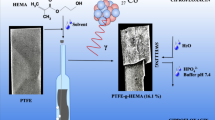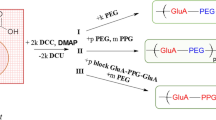Abstract
Radiation sterilization is becoming increasingly popular for the sterilization of many pharmaceutical products. Although this technique is not limited to the sterilization of polymers, it is probably the most suitable method for such materials. This method however suffers several drawbacks. The sterilization of a product must lead to a safety level of 10−6, i.e. one chance in a million to find a contaminated sample. In many cases, this assurance of sterility can be achieved by using a uniform treatment dose of 2.5 Mrad, recommended by the pharmacopeia. We investigated the possibility of using doses of radiation inferior to 2.5 Mrad to sterilize a semi-solid poly(ortho ester) (POE) developed for use as carrier in controlled drug delivery. After determination of the initial bioburden, the polymer was intentionally contaminated with the bioindicator Bacillus pumilus E 601. Following exposure to gamma irradiation, the D10 value of the radio resistant bioindicator was determined. Using the initial contamination value, the reduction factor D10 and the safety level, it is possible to calculate an optimal sterilizing dose for POE. All polymers are affected by ionizing radiation and the amount of radiation which produces a significant change in properties may vary from one polymer to the other. A molecular weight and dynamic viscosity decrease resulting from backbone cleavage was observed for this POE at a dose lower than 2.0 Mrad. Evaluation of the structure using 1H-NMR, 13C-NMR and IR analysis shows that for doses higher than 2.0 Mrad, another degradation process takes place. Formation of two isomeric esters of the triol used for the synthesis was identified by these methods. Cleavage of the monomer cycle is believed to be the main cause of the degradation observed. A radiation dose of not less than 7 times the D10 value but less than 2.0 Mrad was used for this semi-solid biodegradable poly-(ortho ester) in order to ensure its sterility and avoid an excessive formation of degradation products.
Similar content being viewed by others
REFERENCES
J. Heller, S. Y. Ng, B. K. Fritzinger and K. V. Roskos. Controlled drug released from bioerodible hydrophobic ointments. Biomaterials 11:235–237 (1990).
A. Merkli, J. Heller, C. Tabatabay and R. Gurny. Synthesis and characterization of a new biodegradable semi-solid poly(ortho ester) for drug delivery systems. J. Biomater. Sci. 4:505–516 (1993).
S. F. Bernatchez, A. Merkli, C. Tabatabay, R. Gurny, Q. H. Zhao, J. M. Anderson and J. Heller. Biotolerance of a semisolid hydrophobic biodegradable poly(ortho ester) for controlled drug delivery. J. Biomed. Mater. Res. 27:677–681 (1993).
J. Heller, Y. F. Maa, S. Y. Ng and R. Duncan. Recent developments in the synthesis and utilization of poly(ortho esters). J. Contr. Rel. 16:3–14 (1992).
P. Wüthrich, S. Y. Ng, B. K. Fritzinger, K. V. Roskos and J. Heller. Pulsatile and delayed release of lysozyme from ointment-like poly(ortho ester). J. Contr. Rel. 21:191–200 (1992).
A. Merkli, J. Heller, C. Tabatabay and R. Gurny. Semi-solid hydrophobic bioerodible poly(ortho ester) for potential application in glaucoma filtering surgery. Proceed. Intern. Symp. Control. Rel. Bioact. Mater. 20:360–361 (1993).
J. Hoborn. Die Entwicklung der Ethylenoxidsterilisation: technologische Aspekte und toxikologische Sicherheit. J. Pharm. Technol. 6:34–35 (1985).
U.K. Panel on Gamma and Electron Irradiation. Letter to the Editor: Radiation sterilisation dose—The position of the U.K. panel on gamma and electron irradiation. Radiat. Phys. Chem. 29:87–88 (1987).
J. C. Dabord and J. Laizier. A theoretical basis for choosing the dose in radiation sterilization of medical supplies. Int. J. Pharm. 37:1–10 (1987).
A. Charlesby. The effects of ionising radiation on polymers. In R. L. Clough and S. W. Shalaby (ed.), Radiation effects on polymers, American Chemical Society, Washington DC, 1991, pp 39–78.
W. E. Skiens. Sterilizing radiation effects on selected polymers. Radiat. Phys. Chem. 15:47–57 (1980).
A. Merkli, J. Heller, C. Tabatabay and R. Gurny. Semi-solid hydrophobic bioerodible poly(ortho ester) for potential application in glaucoma filtering surgery. J. Contr. Rel. 29:105–112 (1994).
H. Affolter und P. Speiser. Die antimikrobielle behandlung von Arzneiformen mit γ-Strahlen. Pharm. Acta Helv. 48:525–540 (1973).
United States Pharmacopeia (USP XXII). The United States Pharmacopeial Convention, Inc., 12601 Twinbrook Parkway, Rockville, Maryland 20852, USA.
J. C. Dabord and D. Becel. Utilisation d'indicateur biologiques de radiostérilisation: I. Bacillus pumilus E 601. Ann. Pharm. Fr. 39:85–90 (1981).
J. L. Whitby and A. K. Gelda. Use of incremental doses of cobalt 60 radiation as a mean to determine radiation sterilization dose. J. Parent. Drug Ass. 33:144–155 (1979).
W. S. Moos. Variation of irradiation effects on microorganisms in relation to physical changes in their environment. J. Bacteriol. 63:688–690 (1952).
J. C. Darbord, F. Paris and J. Laizier. Sterilization par rayonnements ionisants: détermination de l'intensité des traitements par expérimentation de doses fractionnaires. Ann. Pharm. Fr. 43:241–248 (1985).
P. T. Doolan, N. A. Halls and A. Tallentire. Sub-process irradiation of naturally contaminated hypodermic needles. Radiat. Phys. Chem. 31:699–703 (1988).
D. J. Carlsson and S. Chmela. Polymers and high-energy irradiation: degradation and stabilization. In G. Scott (ed.), Mechanisms of polymer degradation and stabilisation, Elsevier Science Publishers, London, 1990, pp. 109–113.
Author information
Authors and Affiliations
Rights and permissions
About this article
Cite this article
Merkli, A., Heller, J., Tabatabay, C. et al. Gamma Sterilization of a Semi-Solid Poly(ortho ester) Designed for Controlled Drug Delivery—Validation and Radiation Effects. Pharm Res 11, 1485–1491 (1994). https://doi.org/10.1023/A:1018964511053
Issue Date:
DOI: https://doi.org/10.1023/A:1018964511053




